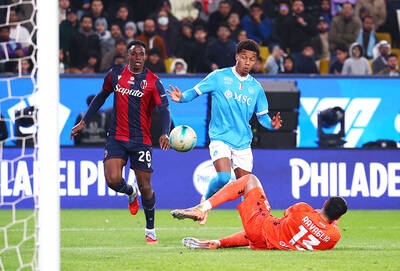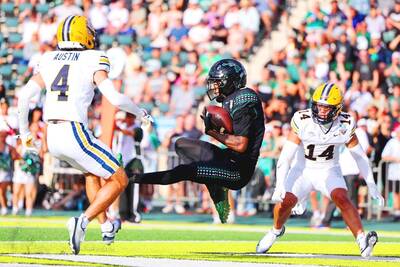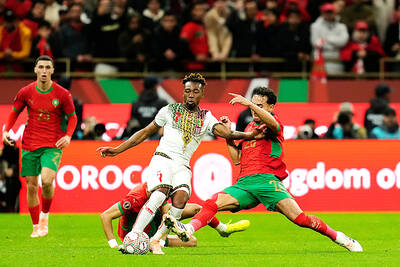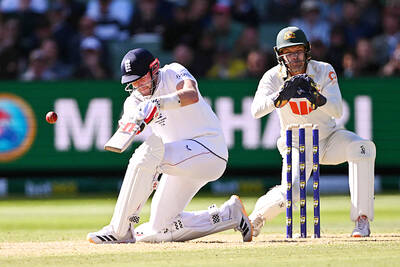It's the moment when World Cup dreams are realized or cruelly shattered.
In a split-second moment, you're either hero or villain.
In polls for worst World Cup penalty miss of all time, Roberto Baggio's ballooned effort in the 1994 final against Brazil is often voted top of the flops.
England's Stuart Pearce and Chris Waddle [against Germany in 1990] and Paul Ince and David Batty [against Argentina in 1998] run a close second.
Some say singer Diana Ross's miss at the 1994 opening ceremony in Chicago was the classic blunder.
But with the aid of science, some say, it's possible to take the perfect penalty and that knowledge will be useful now that the 2006 World Cup has reached the knock-out stages.
So many big matches these days are decided on the 10.97m place kick that sports physicists, psychologists and biomechanicians are often recruited to try to give an edge to striker and keeper.
no-lose situation
Penalties are no-lose situations for the keeper, because almost all of the pressure is on the striker.
Psychologists can enhance this advantage in a number of ways.
One of them is in training keepers in body language. Keepers who are alert to the kicker's eyes, body posture and angle of his feet in the runup can gain as much as half a second in which to move in the right direction.
Scientists at John Moores University in Liverpool showed goalkeepers life-sized video footage of penalties being taken, filmed from the viewpoint of a keeper standing in the center of the goal.
The film was stopped four times during the sequence -- 120 milliseconds before the kick; 40 milliseconds before; at the point of impact; and 40 milliseconds after -- and the goalkeepers were asked at each stage to predict where the ball was being placed.
The researchers found that the biggest clue was the position of the striker's hips just before the strike.
"If the taker's hips are square-on to the goalkeeper in a right-footed kicker, the penalty goes to the right-hand side of the goalkeeper," says the university's Mark Williams.
"If his hips are more `open', or angled away from the goalkeeper, the kick tends to go to the left of the keeper," he said.
But science can also help the penalty-taker, too.
A study in biomechanics carried out at the University of Bath in 2004 determined the maximum reach of a goalie's dive, regardless of his size.
`unsaveable zone'
It showed that, if the keeper stays on his line in accordance with the rules, 28 percent of the goal is an "unsaveable zone" that guarantees a score provided the ball is kicked accurately and with reasonable force.
Even if you can't kick accurately, blasting is still a pretty good option.
"Hit your penalties as hard as possible," advises Kassam. "Research indicates that a penalty struck at more than 20m per second (73kph) stands a greater chance of hitting the back of the net than a slower one, as a goalkeeper has less time to analyze visual clues and react."
Simple psychological tactics can also improve the success rate of a team in the all-important shootouts.
A 2000 study found that if the weakest players take their penalties earliest in the sequence, with the strongest last, there is a big improvement in the team's chances.
According to FIFA statistics, the kicker holds all the cards.
In the history of the tournament, 182 penalties have been awarded with 147 converted or 81 percent.
Thirty-five have been missed with 22 of those saved by the keeper.
That said, there is no substitute for practice.
In the days before computers and penalty specialists, the Hungarian great Ferenc Puskas used the simplest of techniques to ensure that he would slot home a penalty.
He would hang a disc 80cm below the crossbar and aim at it, again, again and again, until he got it right.

TOOTHLESS: Bologna never looked like finding a way back, and Antonio Conte and his substitutes were waiting to celebrate long before the final whistle SSC Napoli on Monday lifted the Italian Supercoppa with a 2-0 win over Bologna in Riyadh, David Neres netting both goals to earn the league champions a deserved victory over the toothless Coppa Italia winners. Neres opened the scoring with a stunning strike from distance six minutes before halftime and found the net again in the 57th minute when Bologna were caught trying to play out of defense. “We came here as champions of Italy, we wanted this trophy and we showed it with a great performance,” Napoli forward Matteo Politano told Mediaset. “We could have scored a few more goals, but

Backup quarterback Luke Weaver on Wednesday night threw a 22-yard touchdown pass to Nick Cenacle with 10 seconds left, as the University of Hawaii rallied for a 35-31 comeback victory over the University of California, Berkeley in a thrilling Hawaii Bowl. Weaver entered the game after Micah Alejado took a hard hit on the previous play. With the Rainbow Warriors (9-4) in range for a tying field goal, coach Timmy Chang took a shot at the end zone, and Cenacle got between two defensive backs and made the contested catch. “How amazing is that?” Chang said. “It’s a program that is built

Hosts Morocco on Friday were held to a 1-1 draw by Mali at the Africa Cup of Nations, ending their world record run of wins and leaving them still to make sure of progress to the next stage. Midfielder Brahim Diaz tucked away a penalty in stoppage-time at the end of the first half, but Mali equalized from the spot midway through the second half through Lassine Sinayoko. Both penalties were awarded after video reviews in a tempestuous clash at the end of a busy day of action at the tournament. Morocco were atop the Group A standings with four points, while Zambia,

An astounding 20 wickets fell on a frantic first day of the fourth Ashes Test yesterday, with Australia all out for 152 before storming back to dismiss England for 110 and leave the clash on a knife-edge. England skipper Ben Stokes won a key toss on a green track and his quicks feasted after sending in the hosts under overcast skies in front of 94,199 fans at the Melbourne Cricket Ground. It was the biggest cricket crowd ever at the cavernous arena, exceeding the 93,013 who watched the 2015 World Cup final, and they witnessed the home side collapse with Josh Tongue